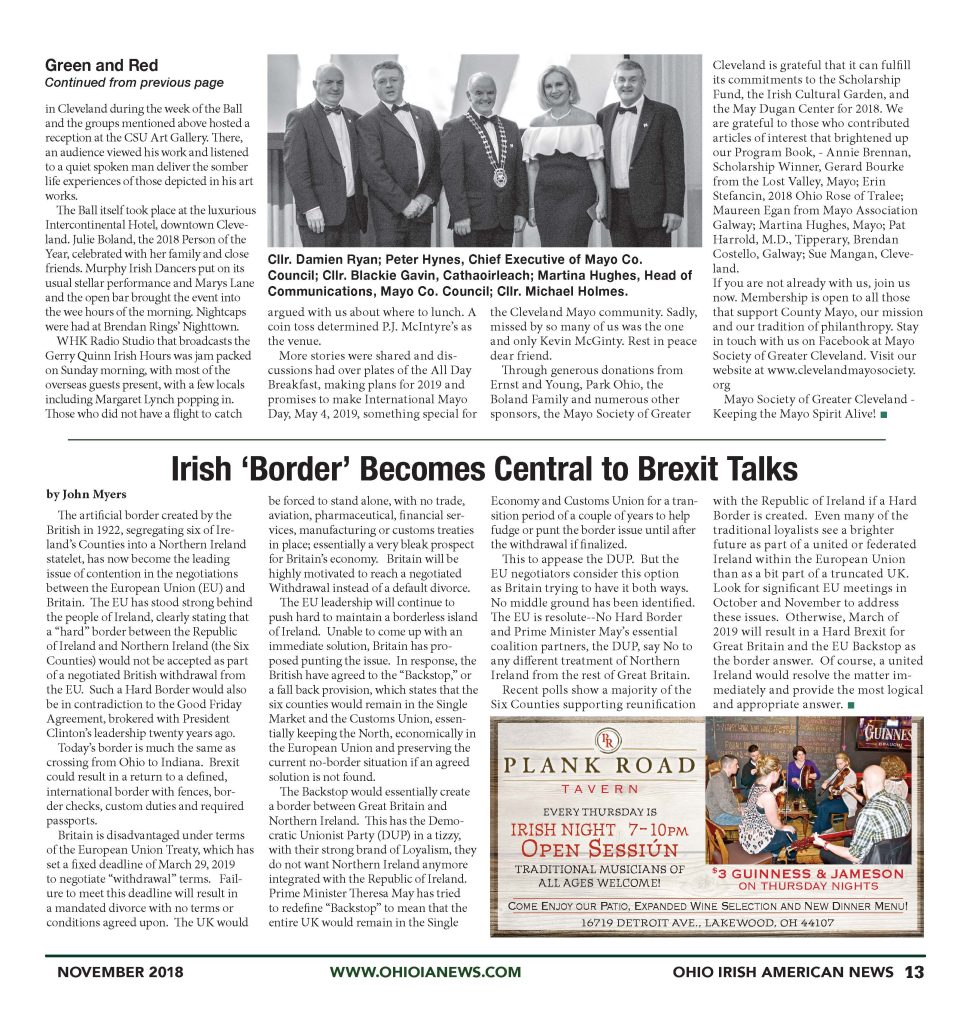
Irish ‘Border’ Becomes Central to Brexit Talks
by John Myers
The artificial border created by the British in 1922, segregating six of Ireland’s Counties into a Northern Ireland statelet, has now become the leading issue of contention in the negotiations between the European Union (EU) and Britain. The EU has stood strong behind the people of Ireland, clearly stating that a “hard” border between the Republic of Ireland and Northern Ireland (the Six Counties) would not be accepted as part of a negotiated British withdrawal from the EU. Such a Hard Border would also be in contradiction to the Good Friday Agreement, brokered with President Clinton’s leadership twenty years ago.
Today’s border is much the same as crossing from Ohio to Indiana. Brexit could result in a return to a defined, international border with fences, border checks, custom duties and required passports.
Britain is disadvantaged under terms of the European Union Treaty, which has set a fixed deadline of March 29, 2019 to negotiate “withdrawal” terms. Failure to meet this deadline will result in a mandated divorce with no terms or conditions agreed upon. The UK would be forced to stand alone, with no trade, aviation, pharmaceutical, financial services, manufacturing or customs treaties in place; essentially a very bleak prospect for Britain’s economy. Britain will be highly motivated to reach a negotiated Withdrawal instead of a default divorce.
The EU leadership will continue to push hard to maintain a borderless island of Ireland. Unable to come up with an immediate solution, Britain has proposed punting the issue. In response, the British have agreed to the “Backstop,” or a fall back provision, which states that the six counties would remain in the Single Market and the Customs Union, essentially keeping the North, economically in the European Union and preserving the current no-border situation if an agreed solution is not found.
The Backstop would essentially create a border between Great Britain and Northern Ireland. This has the Democratic Unionist Party (DUP) in a tizzy, with their strong brand of Loyalism, they do not want Northern Ireland anymore integrated with the Republic of Ireland.
Prime Minister Theresa May has tried to redefine “Backstop” to mean that the entire UK would remain in the Single Economy and Customs Union for a transition period of a couple of years to help fudge or punt the border issue until after the withdrawal if finalized.
This to appease the DUP. But the EU negotiators consider this option as Britain trying to have it both ways. No middle ground has been identified. The EU is resolute–No Hard Border and Prime Minister May’s essential coalition partners, the DUP, say No to any different treatment of Northern Ireland from the rest of Great Britain.
Recent polls show a majority of the Six Counties supporting reunification with the Republic of Ireland if a Hard Border is created. Even many of the traditional loyalists see a brighter future as part of a united or federated Ireland within the European Union than as a bit part of a truncated UK. Look for significant EU meetings in October and November to address these issues. Otherwise, March of 2019 will result in a Hard Brexit for Great Britain and the EU Backstop as the border answer. Of course, a united Ireland would resolve the matter immediately and provide the most logical and appropriate answer.


Monthly newsmagazine serving people of Irish descent from Cleveland to Clearwater. We cover the movers, shakers & music makers each and every month.
Since our 2006 inception, iIrish has donated more than $376,000 to local and national charities.
GET UPDATES ON THE SERIOUS & THE SHENANIGANS!